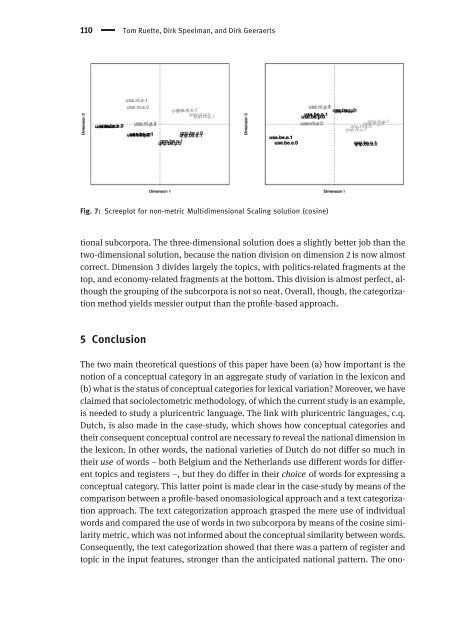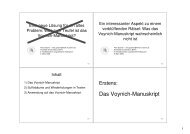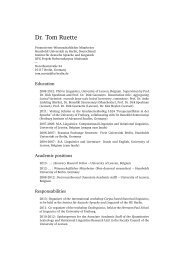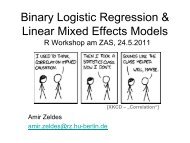Lexical variation in aggregate perspective
Lexical variation in aggregate perspective
Lexical variation in aggregate perspective
Create successful ePaper yourself
Turn your PDF publications into a flip-book with our unique Google optimized e-Paper software.
110 Tom Ruette, Dirk Speelman, and Dirk Geeraerts<br />
Fig. 7: Screeplot for non-metric Multidimensional Scal<strong>in</strong>g solution (cos<strong>in</strong>e)<br />
tional subcorpora. The three-dimensional solution does a slightly better job than the<br />
two-dimensional solution, because the nation division on dimension 2 is now almost<br />
correct. Dimension 3 divides largely the topics, with politics-related fragments at the<br />
top, and economy-related fragments at the bottom. This division is almost perfect, although<br />
the group<strong>in</strong>g of the subcorpora is not so neat. Overall, though, the categorization<br />
method yields messier output than the profile-based approach.<br />
5 Conclusion<br />
The two ma<strong>in</strong> theoretical questions of this paper have been (a) how important is the<br />
notion of a conceptual category <strong>in</strong> an <strong>aggregate</strong> study of <strong>variation</strong> <strong>in</strong> the lexicon and<br />
(b) what is the status of conceptual categories for lexical <strong>variation</strong>? Moreover, we have<br />
claimed that sociolectometric methodology, of which the current study is an example,<br />
is needed to study a pluricentric language. The l<strong>in</strong>k with pluricentric languages, c.q.<br />
Dutch, is also made <strong>in</strong> the case-study, which shows how conceptual categories and<br />
their consequent conceptual control are necessary to reveal the national dimension <strong>in</strong><br />
the lexicon. In other words, the national varieties of Dutch do not differ so much <strong>in</strong><br />
their use of words – both Belgium and the Netherlands use different words for different<br />
topics and registers –, but they do differ <strong>in</strong> their choice of words for express<strong>in</strong>g a<br />
conceptual category. This latter po<strong>in</strong>t is made clear <strong>in</strong> the case-study by means of the<br />
comparison between a profile-based onomasiological approach and a text categorization<br />
approach. The text categorization approach grasped the mere use of <strong>in</strong>dividual<br />
words and compared the use of words <strong>in</strong> two subcorpora by means of the cos<strong>in</strong>e similarity<br />
metric, which was not <strong>in</strong>formed about the conceptual similarity between words.<br />
Consequently, the text categorization showed that there was a pattern of register and<br />
topic <strong>in</strong> the <strong>in</strong>put features, stronger than the anticipated national pattern. The ono-






